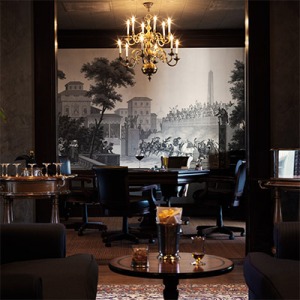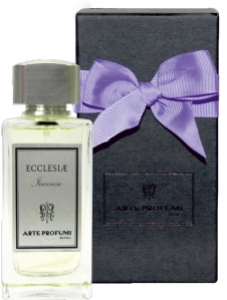The promise of Russian leather, birch tar, smoke, ambergris, and velvet-covered, opulent smoking rooms in gentlemen’s clubs lies at the heart of Fumoir, a new and expensive eau de parfum from the Italian perfume house, Arte Profumi. From the company’s elegant description right down to Fumoir’s notes (which also include pepper, cumin, and rose), the perfume sounds glorious on paper.
Arte Profumi, whose name translates to The Art of Perfume, is based in Rome and seems to have been founded around 2013, the year when it launched all its fragrances. Fumoir is classified as a leather scent, but its name refers to smoking rooms at a gentleman’s club, as well as to a smoke house. Arte Profumi‘s website has little by way of description for the scent, and absolutely no notes:
FUMOIR
Birch
… conversations among men,
in reserved rooms,
covered by wood, leather and velvet
surrounded by smoke.
First in Fragrance has much more information, and describes Fumoir as follows:
“Fumoir” by Arte Profumi is dedicated to a very special world – the world of gentlemen’s clubs and the pleasures of tobacco.
The quite, intense and distinctive fragrance takes no prisoners. Pepper and cumin are the strong vanguard. The fragrance bites wonderfully with smoky and leather notes, the rose in the heart is known only by hearsay and ambergris stays firmly in the background. The rest is pure and driven to extreme masculinity.
“Fumoir” doesn’t rely on hints. Whoever enjoys assertive smoky notes and old, creaking leather, or prefers a statement to diplomacy, will love “Fumoir”. The name in French not only means gentlemen’s room or smoking room but also smoke house.
The notes, as compiled from First in Fragrance and Fragrantica, are:
pepper, cumin, birch tar, tobacco, russian leather, rose and ambergris.

Talisker, an Islay single malt. Photo: Savuista at the Savuista blog.http://savuista.blogspot.com/2013_10_01_archive.html
Fumoir opens on my skin with beautiful birch, manifesting itself as campfire smokiness infused with a peaty, somewhat salty, single malt, Islay Scotch. I’m quite serious when I say that I actually murmured out loud, “Laphroaig on steroids!” which is a huge compliment, as I love Laphroaig the most out of the all the Islay malts. Here, the Scotch is amplified with that gloriously burnt wood, campfire smokiness that is such a core component of birch.
Birch tar is more than just smoky, though. It is often a key element in creating the impression of leather, especially Russian leather. Back in the old days, Russian tanners cured hides with the tar, and something in the popular imagination (or perhaps just in my imagination) tends to associate the leather aroma with dashing, fierce, or untamed Cossacks. (As a side note, Chanel‘s Cuir de Russie probably helped in creating this association.)
Here, in Fumoir, the campfire aroma of scorched birch wood is soon followed by a definite note of blackened, tar-encrusted leather. At this point in the perfume’s evolution, the leather very much feels like its own distinct, individual element. Unfortunately, it later ends up being subsumed into the birch tar, which drives Fumoir from its very first moment until its end.
The leather is really lovely at this point. It is so black and sultry in its smoky, rugged heft. Yet, there is an odd meatiness about it that continuously reminds me of a mesquite-smoked barbecue. Fiery black pepper thoroughly covers it and the overall effect is… well, you may call me crazy, but I keep thinking of Steak au Poivre. Perhaps it’s the result of the cumin with the pepper and birch, creating a combination which my mind is translating into a big, fat, meaty steak, covered with walloping amounts of pepper, and thoroughly infused with smoke from a campfire that is burning mesquite wood. The cumin really isn’t visible in its usual way, apart from that odd impression, and I detect no rose at all at this point.
Instead, Fumoir is a bonfire of darkness, singed woodiness, tar, peaty whiskey, and leather. The latter slowly takes on a slightly animalic touch, a raw, butch quality. For the first time in a long time when smelling a birch leather fragrance, I’m really transported to the steppes of Imperial Russia with its Cossacks. It never really happened with Cuir de Russie, but then, Fumoir is not as refined as that scent and it lacks the avalanche of soapy aldehydes that dominated the Chanel scent on my skin. In short, the Italian perfume has a very untamed, fierce element that the Chanel never did. At the same time, both the campfire smoke and the leather are stripped of the forest or chilly pine aroma that other fragrances with birch often carry.
My favorite part of the scent, though, is definitely the Laphroaig single malt aspect that I noted earlier. As the opening minutes pass, the note grows stronger, and its peaty smokiness works incredibly well with the meatiness of the leather, the pepper, and the birch. Scotch and a campfire steak, how perfect is that?!
Alas, my overall enthusiasm is suddenly tempered exactly 15 minutes into Fumoir’s development when a synthetic note stirs in the base. It smells of very dry tobacco but, also, of an ISO E-like aromachemical. It is wrapped up in an extremely arid woodiness, as well as with a touch of very, amorphous golden… something. I can’t pinpoint what it may be. My first thought was Givaudan’s tobacco synthetic, Kephalis, that is often used for its leathered undertones. Later, though, I wonder if it’s Givaudan’s Ambermax with its peppered, ISO E Super-like notes? The dry, ambergris substitute, Ambroxan? A combination of Kephalis and one of the ambers seems most likely. Whatever the real cause(s) may be, there is definitely something that is not right and very fake in Fumoir’s base.
As a whole, the perfume’s overall bouquet in the opening stage is of tarry birch wood charred in a campfire and infused with mesquite, pepper, Laphroaig whiskey, and meaty Cossack leather, all lightly flecked by a dry tobacco whisper and a good dose of aromachemicals.
Then, Fumoir slowly, very slowly, starts to shift. 40 minutes in, the perfume starts to gradually turn warmer and fractionally sweeter. The peaty whiskey fades away, while a kernel of “amber” in the base begins to bloom, seeping over the tarred leather and birch smoke. It creates a small dot of goldenness in the pitch black, but it is an abstract amber, an impression more than a clearly delineated, crisp note.
And it most certainly is not actual, very expensive ambergris, no matter what is listed in the notes. This is nothing like the scent that dominates a fragrance like Profumum‘s Amber Aurea. This is a wholly abstract construct that is nebulous, dry, and, increasingly, subject to a chemical taint, just like the equally nebulous tobacco note. The “amber” is actually why I mentioned those particular aromachemicals up above. Neither its ISO E-like jangly sharpness nor its excessive dryness is a joy.
The problem is that far too much of both synthetics have been used for them to blend well into Fumoir, though they certainly seem to help with the perfume’s projection. The perfume is very potent in the opening hour, and with good sillage that wafts out about 3-4 inches above the skin before eventually dropping at the end of the first hour. Despite the forcefulness of the birch smoke, Fumoir is quite airy in feel, and it grows thinner with time. Actually, it feels rather like an eau de toilette in nature, one which has a powerful start, but little actual body or depth.
At the end of the first hour, Fumoir is largely a two-note symphony centered on the main aspects of birch: burnt campfire smoke and leather. The pepper, whiskey, and vaguely abstract cumin element have faded away. However, the “tobacco” is finally starting to emerge in its own right, along with the “amber” in base. I don’t mind synthetics in fragrances if they are well-blended, in balanced proportions, and don’t render the scent into something that is heavily chemical in nature, but I have enormous issues when the quantity is high, especially at Arte Profumi’s prices. (More on that later.) Plus, Fumoir gives me a faint headache whenever I smell it too deeply for too long up close. That is a telltale sign that the aromachemicals are in a large quantity, as I don’t have such a reaction otherwise. Needless to say, I’m feeling rather grumpy at this point, and it only gets worse.
At the end of the 3rd hour, Fumoir smells of aromachemical amber, burnt wood in a campfire, and birch tar that is vaguely leathered, all in a warm blend infused with abstract, peppered, tobacco tonalities. It feels richer than it actually is, and it also reminds me of a very synthetic version of Naomi Goodsir‘s Bois d’Ascese, though not as interesting. Fumoir’s sillage has dropped to about an inch above the skin, but the notes aren’t hard to detect up close.
Fumoir is largely linear in nature, which is fine if you like the notes in question. Obviously, I don’t, but it doesn’t help that the simplicity of Fumoir’s bouquet is becoming increasingly boring. From afar, it really is nothing more than the birch tar’s burnt woods and some extremely arid relative of ISO E Supercrappy. For a brief period about 6.25 hours in, the rose appeared, turning Fumoir into a dry, woody rose and birch tar scent on an abstract amber base. It feels like a very distant cousin to Le Labo‘s Rose 31, only the nebulous rose is massively dominated by campfire smoke and an amber synthetic, instead of cedar woods and actual ISO E Super.
The resemblance doesn’t last long, and Fumoir returns to its core scent of birch tar smoked woods with aromachemical amber and aromachemical tobacco. By the middle of the 8th hour, the notes veer between acrid, smoked, and ashtray-like in their nuances. There is a subtle vein of dirtiness that lurks underneath, like really old, stale cumin, mixed with mesquite. The whole thing makes me feel incredibly dirty — in an unclean way, and not in the good, sexy, skanky way.
I’d suppressed the urge for a very soapy shower for hours, but, finally, towards the end of the 10th hour, I gave in and washed off Fumoir. It was exactly 9.75 hours into the perfume’s development, and Fumoir would probably have endured even longer as my skin holds onto synthetics like mad. In all honesty, I think it was the monotony which got to me even more than the acrid, burnt, stale, fetidness of the final hours. Fumoir is all about the birch tar first and foremost, then the two other aromachemicals. The remainder of the notes are hardly key players, and the lovely Cossack Russian leather subsumes itself into the overall scorched woods aroma in a way that renders it a mere undertone in the perfume’s overall scent.
I tested Fumoir twice, increasing the amount of fragrance that I applied, and the overall result was largely the same in both instance. The only difference is that I didn’t detect any rose note with larger quantity of Fumoir. It was just more linear, aromachemical laden, and boring. And I washed it off even sooner.
I couldn’t find any blog reviews for Fumoir, and the fragrance has no comments listed on its Fragrantica page. There isn’t even a Basenotes entry for it. However, Parfumo (which is like a European Fragrantica) has some votes for the quality, sillage and longevity of the scent. So, even if there are no actual comments posted, perhaps you may find 3 people’s numerical assessment of the fragrance useful:
- 3 votes each for Longevity and Sillage, each coming in at an 83% ranking;
- 3 votes for the scent as a whole, which puts it at 2.5 stars or a 50% ranking.
I think the 2.5 out of 5 rating for the fragrance is generally fair, though perhaps a bit high for me personal. Still, it’s telling that 3 people who may not be as annoyed as I am by massive amounts of aromachemicals don’t think highly of the scent either.
It doesn’t help that Fumoir is neither cheap nor easily accessible. It is exclusive to Europe at this point, though you can easily find samples at Surrender to Chance. Even if you were to order it from First in Fragrance in Europe (or Jovoy for EU-based customers), Fumoir costs €225 for the 100 ml bottle. At today’s exchange rate, that comes to roughly $308. This is not a scent worth $308 or €225! It simply is not, even if you don’t share my disdain for aromachemicals. There is none of the rich body, nuanced complexity, or interesting development that would warrant such a price. I generally liked Arte Profumi’s Ecclesiae incense fragrance, though I thought the price for that one was too high as well, but Fumoir lacks its sibling’s quality.
More to the point, if you’re an ardent fan of campfire birch scents, there are much better alternatives out there at a much better price. There is the richer, deeper, piney Arso from Profumum Roma; there is the drier, more austere, interesting Bois d’Ascese from Naomi Goodsir (which is hardcore birch, campfire smoke!); and there is also Jovoy‘s Private Label with its heavy vetiver focus amidst the peaty birch campfire smoke and Mad Max leather. They’re all significantly better fragrances.
In short, Fumoir fails to live up to its promises, and I would skip it.























